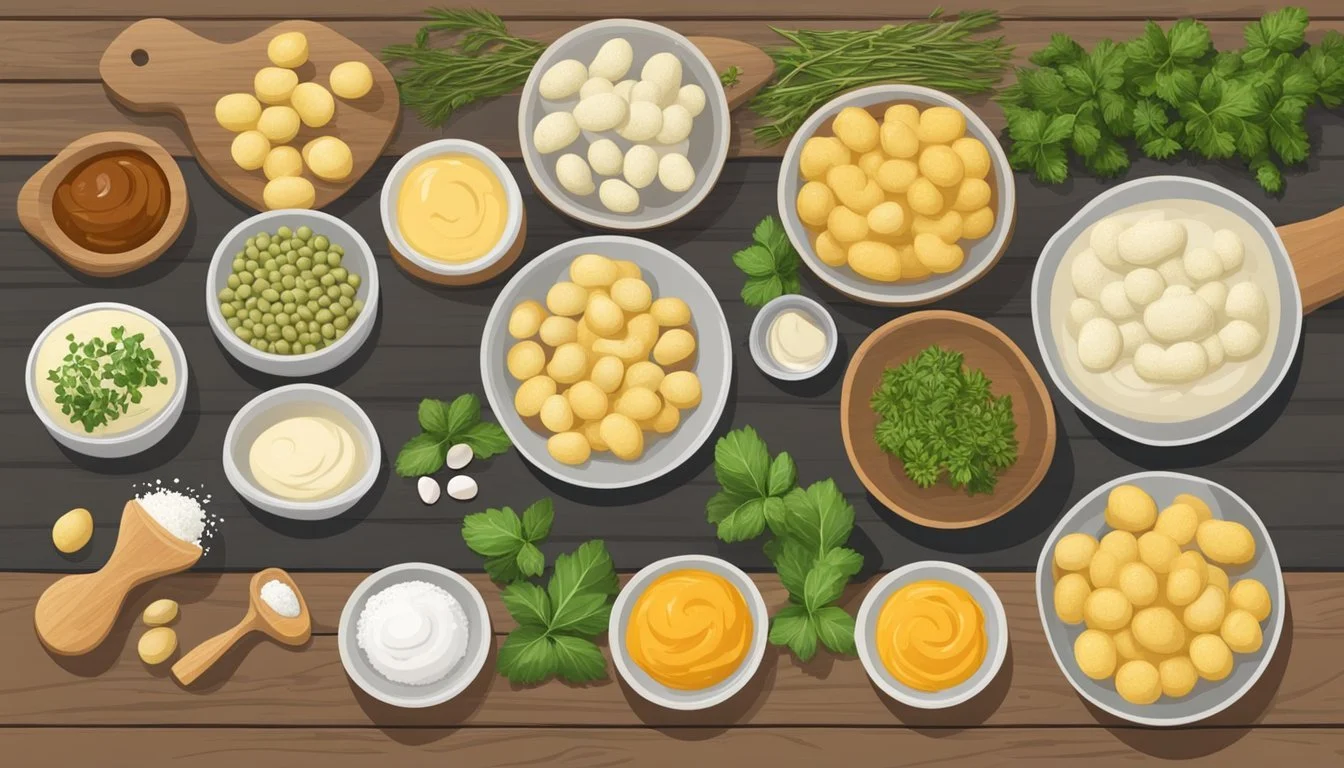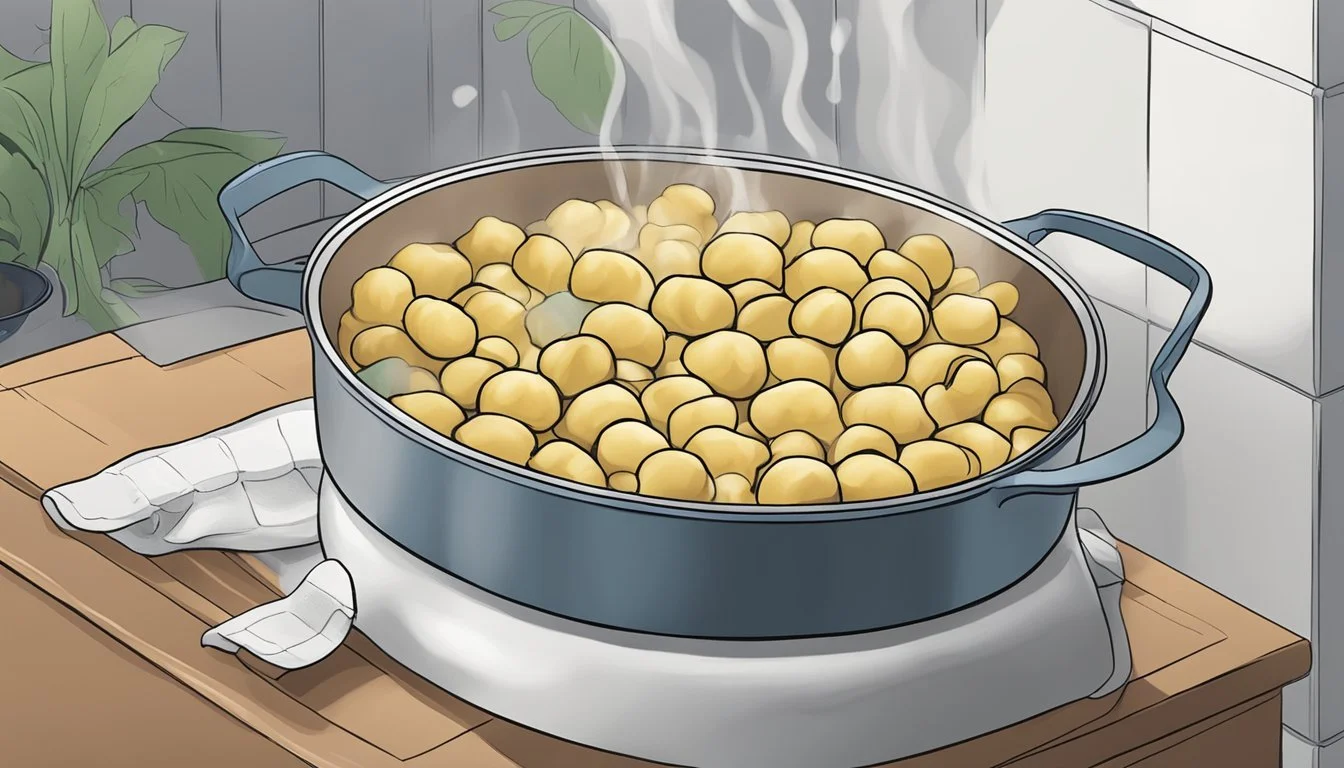How Do You Eat Gnocchi?
Mastering the Art of Enjoying This Italian Classic
Gnocchi, the renowned Italian dumplings, are a versatile and satisfying dish that has made its way to the heart of global cuisine. These small, pillowy morsels are typically made from potatoes, although variations may include semolina, flour, or even ricotta in their composition. Thanks to their delicate texture and ability to absorb flavors, gnocchi can be served as a hearty main course, a light appetizer, or a savory side dish to complement a wide array of entrees.
The process of enjoying gnocchi is straightforward yet allows for culinary creativity. They are best cooked by boiling in lightly salted water until they float to the surface, signifying their readiness. Once drained, gnocchi can be paired with a range of sauces from the classic, such as a simple sage and butter sauce, tomato-based marinara, or a rich gorgonzola cream sauce, to more inventive accompaniments that might include seasonal vegetables or various cheeses.
Key to a successful gnocchi dish is the harmony between the dumplings and their accompaniment. The choice of sauce or condiment is critical as it should complement the gnocchi’s mild potato flavor without overwhelming it. Whether tossed in a saucepan with the selected dressing or served with a sprinkle of Parmesan cheese and a dash of black pepper, gnocchi's appeal lies in its simplicity and the delicate balance of flavors it brings to the palate.
Origins and Types of Gnocchi
Gnocchi, a cherished Italian dish, comprises small dumplings with varying ingredients based on each type's origins. They are a versatile element in Italian cuisine with multiple iterations.
Traditional Potato Gnocchi
Potato gnocchi, the most recognized form of gnocchi, has northeastern Italy as its origin. The classic gnocchi recipe includes potatoes, flour, and eggs, creating a soft dough. These gnocchi are shaped and often have a ridged texture to better hold sauces.
Alternate Flour Gnocchi
Apart from potato-based gnocchi, there are variations using different flours, like semolina. For example, ricotta gnocchi incorporates ricotta cheese for a lighter texture, infusing the dish with a subtle cheese flavor. These gnocchi can be served with various sauces, much like their potato counterparts.
Other Gnocchi Variations
Gnocchi also spans a range of homemade gnocchi traditions across regions. In some parts of Italy, gnocchi are made into round, flat discs and baked with butter and cheese, presenting a different approach to the classic dumpling shape. The adaptability of gnocchi recipes contributes to its continued popularity on dinner tables worldwide.
Choosing Gnocchi
When selecting gnocchi for a meal, consumers face the decision between convenience and customization. Each option provides a distinct experience in both preparation and taste.
Store-Bought Vs. Homemade
Store-Bought Gnocchi:
Convenience: They offer a quick solution for meals, ideal for those short on time.
Variety: They come in different flavors and may include additional ingredients like spinach or tomato.
Shelf Life: They usually have a longer shelf life, making them a practical pantry staple.
Table 1: Comparing Attributes of Store-Bought and Homemade Gnocchi
Attribute Store-Bought Gnocchi Homemade Gnocchi Time Quick preparation Time-consuming Variety Limited selections Customizable Texture Consistent Variable Flavor Standardized Rich & Personalized Skill None required Some skill required
Homemade Gnocchi:
Taste: They can taste fresher and the flavor can be tailored to personal preference.
Texture: They often have a softer, more delicate texture that can enhance the dining experience.
Ingredients: One has full control over the ingredients, which is perfect for those with dietary restrictions or preferences.
Understanding Gnocchi Labels
Key Information:
Ingredients: Look for simple, quality ingredients such as potatoes, flour, and eggs.
Origin: Some labels indicate the region where the gnocchi were made, which can be a marker of traditional methods and authenticity.
Allergens: Allergy sufferers should check for potential allergens, as some store-bought gnocchi may contain additional components.
Preparation Basics
Gnocchi preparation requires a delicate balance of cooking technique and timing to achieve the perfect texture — tender on the outside and soft on the inside. Mastering a few basic techniques can lead to a variety of flavorful dishes.
Basic Cooking Techniques
To cook gnocchi, one starts by bringing a pot of salted water to a boil. Salt adds flavor and helps reduce stickiness. Once boiling, gnocchi are added to the water and cooked until they float to the surface, indicating they are done, which typically takes about 2-3 minutes.
Boiling Methods
Consistent boiling is crucial for cooking gnocchi evenly. One should use enough water to allow the gnocchi to move freely and not overcrowd the pot, as this can result in uneven cooking. It's essential to gently stir the gnocchi to prevent them from sticking to the bottom of the pot.
Alternative Cooking Methods
Beyond boiling, gnocchi can be cooked using various methods to add different textures and flavors. One can:
Sauté cooked gnocchi in butter or olive oil for a crispy exterior.
Bake gnocchi in an oven preheated to 450°F on a lined baking sheet, drizzled with olive oil, for a golden finish.
Pan fry along with vegetables for a quick and savory dish.
Each cooking method can transform leftover gnocchi or elevate an easy gnocchi recipe into an impressive meal with minimal additional effort.
Sauces and Accompaniments
Gnocchi is a versatile dish that shines when paired with the right sauces and accompaniments. From rich creamy textures to light and fresh additions, the right combination can turn gnocchi into a memorable meal.
Classic Sauces
Classic sauces for gnocchi often involve a tomato base or a pesto blend. Marinara sauce is a staple in Italian cuisine, made with tomatoes, garlic, and fresh herbs, which brings a bright and tangy flavor to the soft pillows of gnocchi. For a more robust dish, pesto—a blend of basil, garlic, Parmesan cheese, olive oil, and pine nuts—offers a fragrant and nutty coat to each piece.
Vegetables and Proteins
Adding vegetables and proteins can transform gnocchi into a hearty, all-in-one dish. Bacon adds a salty and crispy dimension, while asparagus introduces a subtle, earthy taste and a pleasant crunch. For an earthier flavor, one might add mushrooms to create a mushroom gnocchi experience, enhancing the umami flavor profile of the dish.
Cheese and Herbs
Completing any gnocchi dish often involves a sprinkle of cheese and herbs. Parmesan cheese is the go-to choice for a sharp, salty kick that complements the soft gnocchi. Incorporating herbs like sage, especially when fried in butter until crispy, offers a unique aroma and taste, bringing an elevated feel to even the simplest of gnocchi preparations.
Serving and Presentation
When preparing gnocchi, the two pivotal aspects are the method of plating and its accompaniment within a meal. The right presentation elevates gnocchi from a mere dish to an impressive culinary experience, whether it's served as a side dish or the main attraction.
Plating Gnocchi
Method:
Use a warm plate to keep the gnocchi at the ideal temperature.
Place a suitable portion size in the center, allowing the shape and texture to stand out.
Visual Appeal:
Keep sauces to a moderate amount, ensuring the gnocchi are coated but not drowning.
Garnish with fresh herbs like basil or parsley for a pop of color and flavor.
Pairing with Courses
As a Side Dish:
Gnocchi pairs well with lighter proteins when served as a side, such as grilled chicken or fish.
As a Main Dish:
Elevate gnocchi to a main dish by mixing with robust sauces like bolognese or creamy gorgonzola.
Consider adding roasted or sautéed vegetables to turn gnocchi into a comforting, easy dinner option.
Advanced Gnocchi Techniques
Exploring advanced gnocchi techniques allows for refining both texture and taste. Crafting homemade gnocchi requires attention to detail—particularly when it comes to ingredient selection and dough consistency.
Making Gnocchi from Scratch
To create gnocchi from scratch, one begins with the right type of potatoes—starchy ones are preferred for their fluffiness, such as Russets. The process involves boiling the potatoes with their skins on until they are tender. Once cooled, the skins are removed, and the potatoes are riced to achieve a fine, fluffy texture. This step ensures a uniform consistency, serving as the base for the gnocchi.
Key Ingredients:
Potatoes (preferably Russet)
Flour (use sparingly to avoid heaviness)
Egg (acts as a binder)
Salt (for seasoning)
Optional: pepper for added flavor
The Process:
Boil and rice the potatoes.
Mix in egg, flour, and seasonings.
Knead gently to form a coherent dough.
Mastering the Perfect Dough
The dough is crucial for good gnocchi—it should be soft but not sticky. Achieving the right consistency is a balance; it's important to add enough flour to hold the dough together, but adding too much flour can result in dense and heavy gnocchi.
Dough Consistency Tips:
Start with less flour, gradually adding until the dough is pliable.
Use a light touch; overworking the dough activates gluten, leading to chewy gnocchi.
Pro Tip: Always taste-test a piece of gnocchi by boiling it before shaping the entire batch. This allows the cook to adjust the dough as necessary. Access to a food processor can streamline the process of incorporating the egg, ensuring an even mixture with fewer risks of overworking the dough. Once shaped, gnocchi can be cooked immediately or frozen for later use.
Creative Gnocchi Dishes
Gnocchi, a versatile and beloved Italian dumpling, serves as an excellent base for a variety of creative and flavorful dishes. This section explores innovative recipes and methods for infusing bold flavors into gnocchi, elevating it beyond traditional preparations.
Innovative Gnocchi Recipes
Gnocchi Lasagna with Spinach and White Beans: Layer soft gnocchi with vibrant spinach, creamy white beans, and rich sausage, topping with grated cheese for a casserole that combines the comfort of lasagna with the novelty of gnocchi.
Gnocchi Mac and Cheese with Peas: Give the classic mac and cheese a twist by incorporating pillowy gnocchi, green peas for a pop of color and sweetness, finished with a crispy breadcrumb crust.
Table 1: Innovative Gnocchi Recipes
Recipe Key Ingredients Description Gnocchi Lasagna Spinach, white beans, sausage, gnocchi A lasagna-inspired casserole with a gnocchi base. Gnocchi Mac and Cheese Gnocchi, peas, cheese, breadcrumbs A textural twist on the traditional mac and cheese.
Infusing Flavors into Gnocchi
Sautéed Gnocchi with Red Pepper Flakes: Pan sauté gnocchi until golden and crispy, then toss with olive oil, garlic, and a pinch of red pepper flakes for a simple yet zesty dish that highlights the dumplings' potential to absorb and showcase bold flavors.
Gnocchi with Black Pepper and Pine Nuts: Toasted pine nuts add a nutty crunch to gnocchi, which is seasoned with grounding black pepper for a dish that strikes a balance between earthy and vibrant notes.
List of Flavors for Gnocchi:
Crispy: Achieved by sautéing gnocchi until golden.
Spicy: Red pepper flakes can add a kick.
Nutty: Pine nuts offer a subtle, toasted flavor.
Earthy: Black pepper provides depth.
Storing and Reusing Gnocchi
When it comes to gnocchi, proper storage is critical for maintaining their texture and flavor, and there are effective methods to revitalize leftovers for another meal.
Freezing and Thawing Procedures
Store-bought and packaged gnocchi can be frozen for extended shelf life. To freeze fresh gnocchi, spread them out on a baking sheet in a single layer and place them in the freezer. Once solid, transfer them to a freezer bag or airtight container to prevent freezer burn and keep them for up to two months. When ready to use, cook the gnocchi directly from frozen; there's no need to thaw.
Revitalizing Leftover Gnocchi
Leftover cooked gnocchi can be stored in the refrigerator for up to 2 days in an airtight container. To rejuvenate them, sauté the gnocchi in a pan over medium heat until they are warmed through and regain a desirable texture. A light drizzle of olive oil can help prevent sticking and enhance flavor.
Common Mistakes and Solutions
Creating perfect gnocchi dishes requires attention to detail and an understanding of the cooking process. Below are strategies to navigate common gnocchi-making errors and improve cooking techniques.
Avoiding Gnocchi Pitfalls
When preparing gnocchi dough, using too much flour can lead to a dense and unpleasant texture. The dough should be cohesive but as light as possible. To avoid this, one should be conservative when adding flour and only use enough to form a soft, workable dough.
Gnocchi requires gentle handling; overworking the dough activates the gluten too much, which should be avoided. It's essential for the cook to knead the dough just enough to bring it together. Here are a few specific tips:
Flour: Add gradually and stop once the dough is no longer sticky.
Kneading: Do so gently and stop as soon as the dough feels uniform and pliable.
Troubleshooting Cooking Issues
When it comes to boiling gnocchi, a common mistake is not using a large enough pot of salted water or failing to wait until the water is at a rolling boil. Gnocchi should be cooked in batches to prevent overcrowding and should be removed from the water as soon as they float to the top.
For those who prefer their gnocchi sautéed, the dumplings can stick to the pan or burn if the pan isn't heated properly or if insufficient oil or butter is used. To ensure a golden and crispy exterior:
Oil/Butter: Heat a small amount in the skillet over medium heat before adding gnocchi.
Movements: Gently turn the gnocchi to brown all sides evenly and prevent sticking.
Roasting gnocchi offers a less traditional, yet delicious alternative. This method avoids the pitfalls of boiling and sautéing, giving a crispy texture throughout. One should spread the gnocchi in a single layer on a tray and roast at high heat, shaking the pan occasionally to turn the gnocchi.
For a flavorful finish, tossing the gnocchi in a brown butter and sage sauce provides a simple yet rich complement. The key is to cook the butter over medium heat until it has a golden-brown hue and emits a nutty aroma before adding fresh sage leaves for that aromatic finish.









